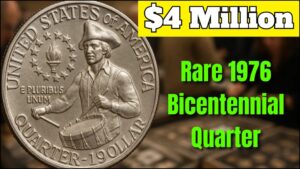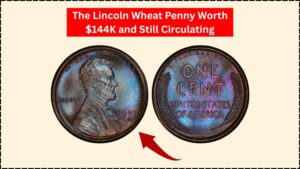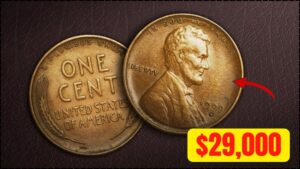Have you ever checked your loose change for a rare coin? A Lincoln Wheat Penny could be hiding in your wallet, potentially worth a staggering $1.9 billion! This iconic penny, minted between 1909 and 1958, is a collector’s dream due to its history and rare varieties. In this article, we’ll break down what makes certain Lincoln Wheat Pennies so valuable, how to spot them, and why they’re still circulating today. Let’s dive in and see if you’re sitting on a fortune!
What Is the Lincoln Wheat Penny?
The Lincoln Wheat Penny, first minted in 1909 to celebrate Abraham Lincoln’s 100th birthday, is one of America’s most famous coins. Designed by Victor David Brenner, it features Lincoln’s portrait on the front and two wheat stalks on the back, giving it the “Wheat Penny” name. Produced until 1958, millions of these pennies are still in circulation, but a few rare ones are worth a fortune.
Why Are Some Lincoln Wheat Pennies So Valuable?
Certain Lincoln Wheat Pennies fetch astronomical prices due to their rarity, errors during minting, or historical significance. For example, specific years and mint marks (the tiny letters indicating where the coin was made) can make a penny worth millions. Below, we’ll explore the key factors that drive their value.
Key Features of a Valuable Lincoln Wheat Penny
To determine if your penny is a treasure, you need to know what to look for. Here are the main factors that make a Lincoln Wheat Penny valuable:
1. Rare Mint Marks
Mint marks are small letters on the coin that show where it was minted:
- D (Denver)
- S (San Francisco)
- No mint mark (Philadelphia)
Pennies with certain mint marks, like the 1909-S or 1914-D, are extremely rare and valuable.
2. Minting Errors
Errors during production can make a penny unique. Some famous errors include:
- Double Die Obverse (DDO): The design appears doubled, making the coin highly sought after (e.g., the 1955 Double Die).
- Off-Center Strikes: The design is misaligned.
- Wrong Planchet: The penny was struck on a different metal meant for another coin.
3. Condition and Grading
The condition of a penny significantly affects its value. Coins are graded on a scale from 1 to 70 by professional services like PCGS or NGC:
- Good (G): Heavily worn but readable.
- Fine (F): Moderate wear with clear details.
- Mint State (MS): Nearly perfect, uncirculated condition.
A Lincoln Wheat Penny in Mint State can be worth thousands or even millions!
4. Key Dates
Certain years are rarer due to low mintage. Here’s a table of the most valuable Lincoln Wheat Penny years and their estimated values:
| Year | Mint Mark | Estimated Value | Why It’s Valuable |
|---|---|---|---|
| 1909 | S | $100,000 – $2M | Low mintage, first year |
| 1914 | D | $50,000 – $1M | Rare Denver issue |
| 1922 | No D | $10,000 – $500,000 | Mint mark error |
| 1931 | S | $5,000 – $100,000 | Low production |
| 1955 | Double Die | $20,000 – $100,000 | Famous error coin |
How to Identify a Valuable Lincoln Wheat Penny
Think you have a rare penny? Here’s how to check:
Step 1: Check the Date and Mint Mark
Look at the front of the penny for the year and mint mark (just below the date). Compare it to the table above for rare dates like 1909-S or 1914-D.
Step 2: Look for Errors
Examine the coin for doubling, especially on the date or words like “LIBERTY” or “IN GOD WE TRUST.” Use a magnifying glass to spot subtle errors.
Step 3: Assess the Condition
Is the penny worn or shiny? Uncirculated coins with sharp details are worth more. Avoid cleaning the coin, as this can lower its value.
Step 4: Get It Appraised
If you suspect your penny is valuable, take it to a professional coin dealer or grading service. They can confirm its authenticity and value.
Why Are Lincoln Wheat Pennies Still in Circulation?
Despite being over 60 years old, many Lincoln Wheat Pennies are still found in pocket change. Here’s why:
- High Production: Billions were minted, so many remain in circulation.
- Durability: Pennies were made of copper (until 1982), which lasts a long time.
- Collector Oversight: Some rare pennies go unnoticed by non-collectors.
Where to Find a Lincoln Wheat Penny
You don’t need to dig through a museum to find these coins. Try these places:
- Change Jars: Check your spare change or ask family members to look through theirs.
- Coin Rolls: Buy rolls of pennies from banks and search for rare ones.
- Flea Markets or Estate Sales: Old coin collections often surface here.
- Coin Shows: Attend local coin shows to buy or learn more about rare pennies.
How to Sell a Valuable Lincoln Wheat Penny
If you find a rare penny, here’s how to cash in:
- Get It Graded: Professional grading adds credibility and value.
- Visit a Coin Dealer: Local dealers can appraise and buy your coin.
- Auction Houses: For high-value coins, auctions like Heritage Auctions can fetch top dollar.
- Online Marketplaces: Platforms like eBay work, but beware of fees and scams.
Tips to Avoid Scams
The coin market has its share of fakes. Protect yourself with these tips:
- Verify Authenticity: Only trust certified coins from reputable grading services.
- Research Sellers: Work with established dealers or auction houses.
- Be Wary of “Too Good to Be True” Offers: If a penny’s price seems unreal, it probably is.
Why Collectors Love the Lincoln Wheat Penny
The Lincoln Wheat Penny isn’t just about money—it’s a piece of history. From commemorating Lincoln to surviving decades of use, these coins tell a story. Collectors cherish them for their beauty, rarity, and the thrill of the hunt. Even if you don’t find a $1.9 billion penny, discovering a rare one can still bring a tidy profit.
Start Your Treasure Hunt Today!
Next time you empty your pockets, take a closer look at those pennies. A Lincoln Wheat Penny worth millions could be hiding in plain sight. Check the date, mint mark, and condition, and you might uncover a life-changing find. Happy hunting!




